Cot Mattresses
November 2016Cot and Baby Mattresses Explained
Whether it’s a cot, cot bed, Moses basket or crib the same confusing language found in mattresses will bamboozle and confuse you. This article should help clear up what you should be looking out for and how to tell the quality cot mattresses from the cheap and nasties. This should take at least one worry off your list!
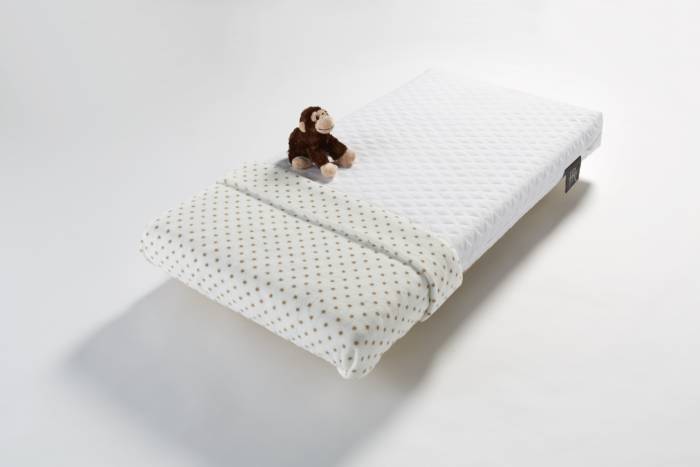
Cot mattresses provide the sleeping surface for your baby from the time they arrive in the world to around the age of 2-3 years old. This is a crucial time, not only for your child but for you. You’re going to be frantically getting used to the change in routine and ensuring your child has all the things they need. We can bet that sleep is going to be one of the areas of your life that will become immensely precious! It’s the same for your child though too which is why a suitable mattress is so important. You want to minimise the chances of an unsuitable mattress causing your child a restless nights sleep.
- Babies sleep patterns
- Natural fibre cot mattresses
- Cot mattress support
- Hypoallergenic cot mattresses
- Cot mattress covers
- What is a pinsonic mattress cover?
- How to choose a cot mattresses
- What is the worst kind of cot mattress?
- Why foam cot mattresses are a bad idea
- How to compare cot mattresses
- What is a cot bed?
- How to clean a cot
Babies sleep patterns
Babies can have wildly different sleep patterns, some sleeping all the way through the night in regular routines to the complete opposite of sleep being unpredictable and random. Whilst a mattress can’t predict a babies sleep pattern it can certainly reduce the risk that an unsuitable mattress contributes to your babies sleep disturbance.
Being too hot or too cold
Managing the temperature of your baby can be tricky, especially given that if a baby is too warm or too hot they will be in distress. However, with a cot mattress, there are some simple rules that if you follow you can avoid your cot mattress becoming another contributor to your baby becoming too warm. You need to avoid entirely synthetic materials where ever possible. These are usually found with cheaper synthetic mattresses and especially foam cot mattresses.
Phrases like 100% recycled material, white fibre, CoolMax or any other science jargon phrase that you’ve been scratching your head about usually mean one thing, that they are entirely synthetic fibre. If they were a natural fibre they would be shouting about it!
Natural fibre cot mattresses
Natural fibres are beyond a doubt superior to their synthetic man-made equivalents. Sadly the majority of cot mattresses are nearly entirely synthetic meaning that they are slow to wick moisture, heat retentive and made of a whole set of chemicals and compounds not ideal for young delicate babies. They are, however, incredibly cheap, surprising given the high cost of some established retailers synthetic cot mattresses! Natural fibres are incredibly resilient and far more capable of ensuring better heat distribution and have a much longer shelf life compared to polyester and other ‘white fibres’.

We have already covered in detail here how to find natural fibres in a mattress and work out the GSM which can be read here. Simply seeing a label with ‘contains natural wool’ is meaningless, you need to know the GSM (Grams per square meter) and if it is blended, what the ratio of the blends is i.e. 4% wool 96% polyester. In this example, it’s basically polyester pretending to be wool. The wool in this blend will have zero positive impact. It will still be a synthetic fibre. Shocking we know, but the majority of natural fibres are blended with polyester.
What you need to look out for is the GSM listed in your cot mattress and if the natural fibre is blended. If it is blended you need to know the percentage blend and what else it is blended with. If a retailer can’t tell you, maybe look elsewhere as you may be paying a premium for a product that is more synthetic than natural.
Cot mattress support
The cot mattress also needs to be able to accommodate a range of sleeping weights, pressure, turning and movement. As your baby grows the mattress needs to be able to support the increase in weight and be progressive enough (i.e. able to react to pressure and return to its original position quickly) to adapt to your babies movements. Foam or even recycled polyester air flow pad is the slowest of all mattress materials taking the longest to return to its original shape. This means that your baby can end up resting in the same position struggling to turn and move during the night leading to discomfort or irritation.
Natural coir that is coated with a latex spray is the most responsive and progressive of all cot mattress materials. It acts as a natural ‘spring unit’ with each of the hairs having incredible flex and strength. This is because the coir acts as a protective layer between the outer husk and the inner seed of the coconut so when it falls from the tree the seed isn’t damaged. It acts as an insulating support unit for the coconut. It’s one of the only natural materials to be naturally resistant to saltwater damage. When cleaned and carded into a pad a layer of latex sprayed over it gives it, even more, flexibility and support.
Open coil springs are the least suitable for cot mattresses as they are not progressive enough compared to coir or pocket springs. They are sluggish and when your baby moves one part of their body the entire spring unit reacts, like a massive amplifier. Pocket springs react individually and are much more suitable, they can react to micro-adjustments much more easily. If you see the words, continuous coil, or miracoil on your baby cot mattress this means open coil.

Support for sleeping babies heads
It’s a known fact that babies when young are top-heavy, by this we mean that their heads weigh significantly more than any other part of their body. What most mattress manufacturers don’t consider, especially with cheaper foam or synthetic cot mattresses is that the mattress has to be breathable. If not babies can suffer from neck sweats, where the head indents too far into the cot mattress and starts to overheat. This causes sweats which upset and distress the baby but also can transfer into the mattress making it damp and softening it over time. This is why we would always argue against a synthetic mattress, i.e. shredded polyester or ‘white fibre’ as this is the least breathable of mattress fibres.
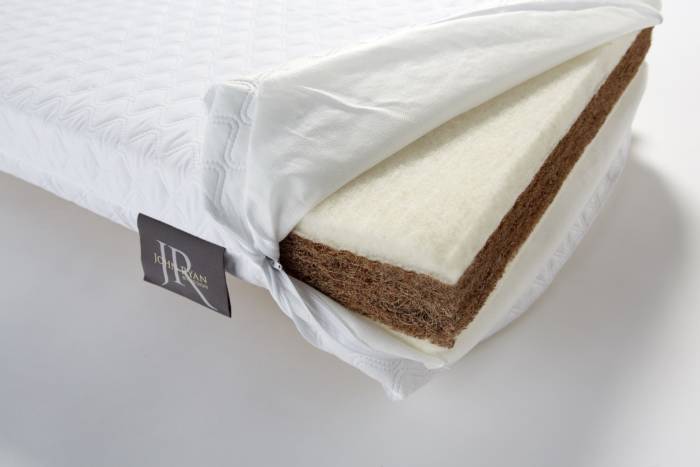
The great thing about coir is that if any moisture occurs it is high wicking and resistant to salt water. Meaning it will dry quicker and not be damaged by sweat or other bodily fluids, unlike the slow to dry synthetic alternatives. Our John Ryan By Design Cot mattress is suitable for a baby or young child up to around 16kg in weight or 2-3 years of age. After that, you will need to look at a conventional mattress or equivalent. Please call us in 0161 437 4419 for further help on the move between a cot mattress and regular mattress.
Hypoallergenic cot mattresses
New parents are right to be concerned about dust, allergies and contaminants in their babies mattresses. Infants lungs are still developing so you want to reduce the chance of any dust, toxins or off-gassing from affecting your newborn. Natural fibres such as lambswool are naturally hypoallergenic as is coir and latex. However, allergies and dust cannot be completely eradicated so maintenance is key to reducing this.
The main issue with allergies is when cot covers and sleeping blankets are not adequately cleaned on a 60-degree wash. This is when dead skin, dust from the environment or other contaminants can make a home in your babies cot. Natural fibres are more breathable than their synthetic and foam based counterparts. This helps to reduce mould spores and allergens from nesting in your babies cot.
Whilst a cot mattress maybe hypoallergenic once it is out of the packaging this level allergy reduction will entirely depend on the cleaning and maintenance undertaken by parents. We would advise you to put more thought into the actual materials than whether they are labelled as hypoallergenic as even polyester can be labelled as allergen-free!
Cot mattress covers
The cover of the cot mattress is of utmost importance as this is the one barrier between any accidents and the mattress. There are two options with a cot mattress cover, you can either go for the 100% natural which won’t be waterproof or a waterproof cover that’s either entirely synthetic or a blend. Most parents go for the waterproof cover as this is the most practical.
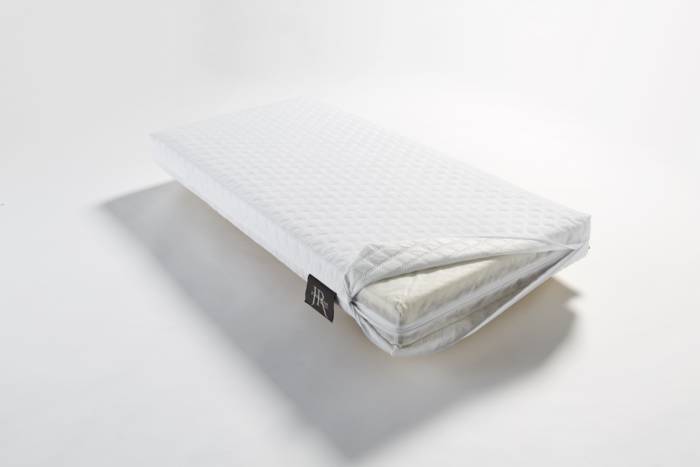
Whilst it’s great to have an entirely 100% natural fibre mattress and cover it also means that any soiling that occurs will directly enter the mattress, sometimes making the mattress unusable. We advise you are better with a waterproof mattress cover and then 100% natural sheets, blankets and comforters instead. These will be directly in contact with the baby so they get the benefit of natural fibres without any little accidents from ruining your new cot mattress.
Our cot mattress is supplied with two pinsonic microfibre covers and an internal water resistant hair proof cover. We supply two covers so you can replace it immediately after any accidents or spills and not have to wait to wash and dry the cover before remaking the cot for your child. We know how convenience is a priority when you have children!
What is a pinsonic mattress cover?
A pinsonic quilted cover is where a material is heat-bonded together instead of being stitched. This can be done in an unlimited array of patterns and prints and to the naked eye looks like it has been quilt stitched. This is also known as fuse-bonding and has the advantage of giving the look of a quilt but without any stitching that babies nails and fingers can get caught in because it is sonically heat bonded very quickly. It’s another method used to help reduce the risk of injury to a child.
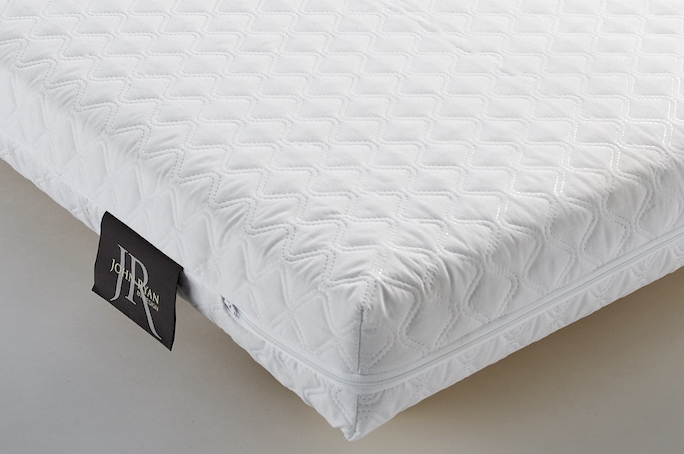
How to choose a cot mattress
There are three main criteria you should focus on when choosing a new cot mattress for a baby or infant.
The first is support, the second is upholstery & airflow and the last is the cover fabric. By comparing cot mattress models against these three criteria, you should be able to sift the good from the bad. Avoiding some of the models that cause endless issues with infant and baby sleepers. It will also allow you to ensure you’re not mistakenly buying a ‘bargain’ that actually turns out to be a nightmare for your little sleeper.
Support
Infants and babies need a firm support unit when they are first born. This usually surprises parents who think the small weight of a baby will require a soft squishy mattress. Babies require firmer support as they are less capable of keeping themselves aligned properly during the night. This is because babies are still getting used to movements and are really dependent on their parents to help support them during the day, the same is true of the mattress. You need a cot mattress that can offer consistent support without sagging.

Pocket springs or latex coated coir are the best for this as they do not deform or sag as foams do. They are also far more breathable than solid foam counterparts.
The worst kind of support is synthetic foam. This is because it isn’t progressive enough for babies.
When a material is progressive it refers to the amount of sink a weight causes on the material before support kicks in. If something is very progressive it offers a quick sink before support starts to push back against the sleeper. Progressive materials return to their original position far quicker as well. Rather than the opposite which is sluggish foam or super sink polyester material that gives too quickly, with no support.
Cot mattress foam conforms to little sleepers slowly, but can then keep them stuck in a hollow because the foam is slow to react when they try to move. This crater effect, that the babies body weight has caused on the foam, can keep them held uncomfortably in one position. This can then cause them to overheat. Making your baby uncomfortable and damp. We have written extensively about the issues with memory foam here which may be of interest, especially their chemical composition.
Cheap PU Foams also have a very short shelf life and degrade very quickly, especially when wet or damp. This means that whilst you may have found a bargain discount cot mattress, it’s actually a false economy. It will cause more problems than it is worth.
Upholstery & Airflow
Upholstery should be the primary factor when choosing cot mattresses, with the exception of price. You want to ensure that for your budget you are buying the most natural and responsive material possible. The ultimate upholstery is a natural fibre, such as natural wool. If a fully natural fibre is out of your budget, a blended pad of wool and polyester is far better than a synthetic foam or recycled pad.

Airflow and breathability are also hugely important for babies during the night. Babies can often suffer from night sweats, especially when they are ill or distressed such as when teething. A breathable mattress material like coir, lambswool or horsehair will allow any perspiration to wick away from your baby and not cause dampness like some foams and cheap recycled fibre mattresses.
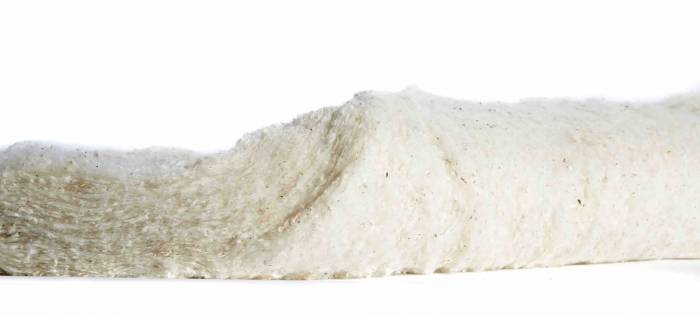
This airflow also helps your child regulate its temperature which should reduce fluctuations in temperature greatly. Foams completely struggle to wick moisture away leaving babies sweating and creating a damp mattress.
Cover fabric
There’s a really lively debate on cot mattress cover fabrics. On one side we have the natural fibre camp, who quite rightly argue that natural fibres are the better material as they are breathable. Then on the other side, we have the water-resistant camp, who will argue that natural fibres are pointless because as soon as the baby soils the bed, which it inevitably will, the natural fibre allows any waste to soak through quickly and damage the mattress.
This may surprise our John Ryan By Design fanbase, who knows how much we campaign for natural fibres day and night, but we support the water-resistant camp when it comes to cot mattresses. Opting for a polyester pinsonic cover and water-resistant internal cover to both protect the mattress and your baby.
We have created a breathable cover with our pinsonic polyester cover. It can be washed at 60 degrees, unlike some natural fibres and will keep its shape far longer. It will accommodate an accident or spillage and the internal water-resistant cover will prevent the contents penetrating through, meaning the core mattress is protected from damage. Making it a very convenient choice for you busy new parents!

We also always provide two outer covers will all our cot mattresses saving you the mad panic rush to wash dry and refit the cover. We know you will have far more on your plate as a new parent and the speed changing of mattress covers should not be something you need to contend with!
We also add a water-resistant hair proof cover, see above beneath the external cover, to stop any of the natural fibres migrating through and into the cover. If you’re looking at natural fibre cot mattresses you should always look for this. A hair proof cover is a sign of a high-quality cot mattress manufacturer, we have seen models without this which will lead to irritation if fibres shift as they can do.
What is the worst kind of cot mattress?
The worst kind of cot mattress (and mattress cover) is an entirely synthetic vulcanised non-breathable plastic which covers a synthetic foam core. Obviously, if your budget is limited then a foam mattress may be the only option. We would recommend white fibre rather than solid core foam if this is the case.
It’s also worth bearing in mind that ‘waterproof ‘ cot mattresses and covers usually mean entirely synthetic and non-breathable, whereas water-resistant means that it will stop water penetrating through for a short period of time, usually a few hours before it starts to soak. This means you have time to change the cover and also allows it to be breathable.
There is a huge difference as the waterproof cover has the same issue that foams suffer from which is they cause perspiration. They don’t allow airflow and can cause your baby to overheat very quickly.
Why are foams a bad idea for cot mattresses?
Foams are incredibly useful for a variety of household products including mattresses. They are cheap to make, easily cut to size and come in a variety of densities and firmness ratings. However, the one thing foams cannot handle is moisture. When introduced to moisture, humidity or any of the other liquids that babies may produce on their mattress foam starts to suffer. This is because foams are incredibly slow to dry and can trap leaks and spills these then remain within the foam.
If you imagine a sponge scourer used in the kitchen, when it gets wet you have to ring it out or it sits there, festering and turning stale. This can also happen with your mattress. If they are left wet they can then degrade the foam, may start to mould and your poor little one is left sleeping on a less than an ideal surface.

Basic foams also have a short shelf life when it comes to sagging and dipping. In fact, most cheap cot mattress foams will start to degrade after a few months use especially as babies temperatures can fluctuate along with the moisture issue. You may soon find a mattress that has dips and sags in it, which worst case can pool liquid, especially around the head area, leading the risk of suffocation with your baby. Natural fibres such as coir or pocket springs with an upholstery layer like lambs wool are far more durable and breathable, meaning that they can recover from spills and fluctuating temperatures much more quickly.
How to compare cot mattresses
We are often asked how exactly to compare cot mattresses. We have written extensively on how to compare mattresses; essentially knowing the exact support unit, GSM and upholstery layers which most manufacturers won’t tell you. It’s exactly the same for a cot mattress.
You need to be able to assess the support unit provided and how many layers of upholstery are contained within the mattress. It’s essential that you find out as much about these components as possible. The GSM (Grams per square meter) will give you an idea of the volume of upholstery (usually the higher the better as a general rule) and the percentage of natural fibres. Below is a table that compares three of the high-end current cot mattresses against our John Ryan Naturals Cot Mattress. This should give you an idea of the kind of information you need to compare. If you have questions though please feel free to call us on 0161 437 4419 to help compare with you.
| Layers | Boori Natural Pocket Sprung Cot Mattress | Little Green Sheep Organic Cot Bed | Silent Night | John Ryan Natural Cot Mattress |
|---|---|---|---|---|
| 1 | 100% Cotton Cover (Non removable) | Single Cotton Cover | Unknown cover fabric | 2 Pinsonic microfibre zip off covers |
| 2 | 100% British Wool (No GSM) | Wool layer (No GSM) | AirStream™ 50% Recycled Foam Free Fibres (No GSM) | Hair proof water resistant cover |
| 3 | 2 Layers Spun bond pocket springs (No count given) | Coir & latex layer (No GSM) | Spun bond pocket springs (No count given) | 500GSM Lambs Wool |
| 4 | Coir (No GSM) | NA | NA | 3750GSM Coir sprayed with latex |
| Cover Washable? | No | Yes (Unknown temperature) | Yes at 40 degrees | Yes at 60 degrees |
| Total Depth | 10cm | 10cm | 10cm | 10cm |
| Retail Price | £299.99 | £199.99 | £249.99 | £165 |
What is a cot bed?
A cot bed differs to a cot as it has adjustable heights for the base and sides. Meaning it can be raised or lowered. Whereas a cot is one height and size with very few adjustments. A cot bed allows you to have the mattress base higher for newborns and then adjust it lower down as your little one grows. Cot beds can also convert into toddler beds and can be used anywhere up to 5 years of age. They are really versatile!
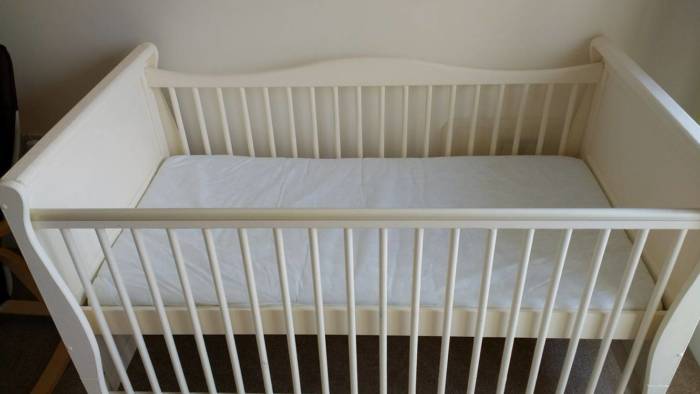
Cot beds can save you considerable money and fuss as your baby grows. As you’re not having to swap between cot, mini toddler bed and then single mattress.
Cot beds allow your child to grow, sit and stand with the base being lowered keeping them safe. The size of a cot bed mattress is 140cm x 70cm, slightly larger than a standard cot mattress.
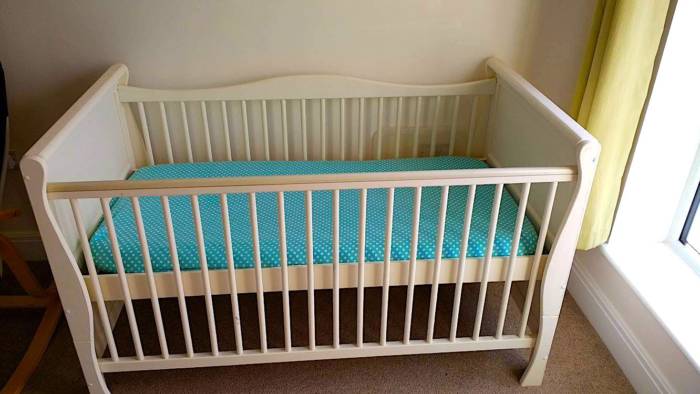
How to clean a cot
- Aim to fully strip back the mattress weekly washing the removable covers or sooner if they get soiled.
- Vacuum the cot out and the surrounding area.
- Wash the cot mattress cover, blankets and comforters on a 60-degree wash with a detergent suitable for young infants.
- Ensure that if you’re sponge cleaning the cot that you completely dry it either with a clean towel or air drying the area. Mould and spores love warm damp areas.
- When making the bed ensure you tuck the covers tightly around the foot of the cot, ensuring that you use the foot to foot sleeping position on their back, as detailed by the NHS here.
There’s so much to consider when you have a newborn child, don’t let your cot mattress become one of your stressors. Using this article as a guide you can see exactly what to watch out for, avoid and look for in your new cot mattress.
It’s paramount that your cot mattress offers adequate support for your little sleeper who will be dependent on it as they grow. Secondly, the airflow brought by the use of natural fibres present in a high-quality cot mattress will help to regulate your babies sleeping temperature and if they do sweat it will quickly wick away any moisture. Lastly, a 100% natural cover that isn’t water resistant is only preferable if your newborn won’t have any little accidents! It is far better to have a water-resistant cover and spare external cover to ensure that when accidents happen, the mattress is not damaged beyond use and that you can change the covers without needing to have a mad panic to wash, dry and press the cover before you can remake the crib!
Summary
Our advice is to avoid foam mattresses and vulcanised rubber covers where at all possible if your budget allows. They cause your baby to potentially overheat and if they start to perspire, there is no way to wick the moisture away. Our cot mattress only uses natural fibres and lambswool meaning no synthetic chemical foams or other white fibres. It’s available in two sizes and comes with a 3-year guarantee. If you need more help then why not give our expert team a call on 0161 437 4419 for more recommendations.
For more information on cot mattresses, please see our guide on Cot Mattress Safety.

Dreaming of the perfect nights sleep?

Ask us a question
There are over 6000 questions and answers submitted by you on all questions about mattresses and bed problems. Enter a keyword such as Vi Spring, John Lewis beds, bad back or Memory Foam and see if your question has already been answered.
If you can’t find an answer in knowledge hub, ask a new question. We aim to respond to all questions within one working day.
Newsletter
Enter your email to join our newsletter. We’ll send you occasional news and mattress expertise.
